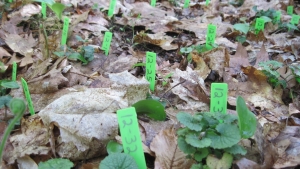You are here
Garlic Mustard Research
Garlic mustard (Alliaria petiolata) is a highly invasive plant that aggressively outcompetes native forest plant species.

It is well established that invasive plants can alter species composition and diversity as well as ecosystem function in communities that they invade. Whether and how species of similar ecosystems respond in predictable ways to invasion at the landscape scale is less understood.
Long-term research at the Forest has determined how this exotic plant invades so rapidly and successfully. Garlic mustard exudes phytochemicals in the soil, which disrupt the important relationship between native plant roots and beneficial soil fungi, impeding native plants' ability to thrive.
Studies that compare invaded and non-invaded communities at the landscape scale are critical for making broad ecological interpretations about the invasion process and its potential to disrupt native community structure. In addition, this approach can help guide invasive plant management, which is frequently done on an ad-hoc basis at a local (parcel) scale.
Garlic mustard (Alliaria petiolata) is an invasive plant of particular concern in North American temperate forests. Its ability to invade the understory of these forests is shared by few other invasives, and it grows in high density patches that suppress the growth and recruitment of native understory plants and dominant tree seedlings. Research over the last decade has also demonstrated the ability of garlic mustard to interrupt the associations that plants form with mycorrhizal fungi. Many plants depend on their associationswith mycorrhizal fungi for growth and survival, as they obtain nutrients from the fungi that they would not otherwise be able to access.
This study, led by Kristina Stinson, will further the understanding of the impacts of garlic mustard on native plants and soil biota, and the potential to control garlic mustard and restore native plant communities in a climate change context. Our specific research goals are to 1) determine the responses of soil microbial communities, plant communities, and ecosystem function to experimental garlic mustard eradication treatments, and 2) determine the impact of experimental garlic mustard invasion on soil microbial and plant communities within soil warming and nitrogen fertilization treatments.
Measurements include plant community cover and density surveys, plant biomass collection and analysis, physiological measurements and soil sample collection. These data are collected at eight sites located in Massachusetts, including the Harvard Forest and southeastern New York.
The research includes a careful eradication plan for experimental plants.
This project is a part of the Harvard Forest Long-Term Ecological Research Program.

